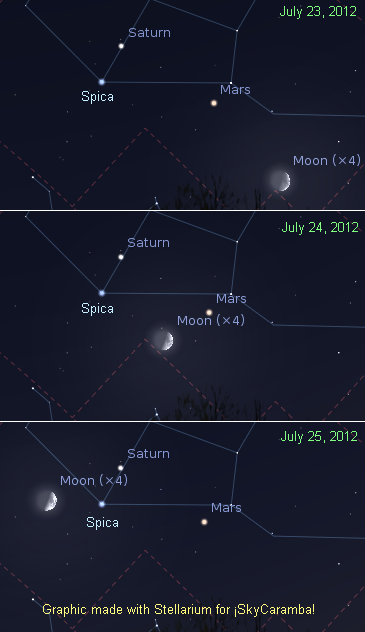¡SkyCaramba! Weekly astronomy blog for the week ending July 28, 2012
I hope you got a good view of the waning crescent moon, Jupiter, Venus, and the star Aldebaran earlier this month. If getting up in the morning to see that kind of thing isn’t for you, you can see a waxing crescent moon near two other planets and a bright star after sunset. The best viewing dates are July 23, 24, and 25.
Saturn is one of the farther planets, so it spends months or even a few years at a time in each constellation it moves through. The ringed planet has been lingering near Spica, the bright star in Virgo, since the later part of  last year. It’s going to head eastward toward the constellation Libra in the next few months.
last year. It’s going to head eastward toward the constellation Libra in the next few months.
Mars is bit closer to the sun than Saturn. So, the red planet moved a little faster through the sky. It’s heading eastward toward Saturn and Spica and will soon pass them. You’ll notice the difference from night to night. Saturn moves a little bit against the background of stars. Mars moves a lot more. It will be right in between Saturn and Spica on August 14. Less than a month later, it will be distinctly in Libra while Saturn is barely moving away from Spica.
The moon is orbiting the earth while the earth orbits the sun. And so the moon is the fastest astronomical object. You can notice the moon’s movement against the stars from hour to hour when it’s up all night. It’s not up all night in the crescent phases, but the evening to evening movement is exciting too.
As darkness sets in after sunset on July 23rd, look for a the moon in the west. It’ll be a thin crescent four days old with plenty of earthshine still visible. That’s the reflection of sunlight from Earth to the dark Earth-facing side of the moon and back.
In the northern hemisphere, Mars will be a little above and left of the moon. Close to the equator, Mars will be above the moon. And in the southern hemisphere, Mars will be up and to the right.
Saturn is a little farther away. As with Mars, Saturn will be up and to the left for observers in the northern hemisphere, above the moon and Mars for those close to the equator, and up and to the right for those far south of the equator.
Spica is fairly close to Saturn. It will be below and left of Saturn from northern hemisphere locations, left of the ringed planet close to the equator and into the southern hemispere’s middle latitudes, and above and left of the planet very far south.
On the evening of the 24th, a thicker crescent moon is much closer to Mars. For some observers, it will be below the red planet. And on the 25th, an even thicker crescent moon will have passed Spica and Saturn. The moon will keep moving eastward and come this way again in about a month.
Keep watching the planets as they move from night to night over the weeks and months ahead. It’s fun to be able to look up and know which object is which.
¡SkyCaramba!